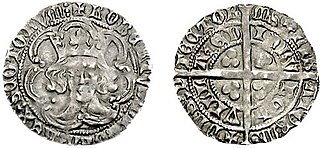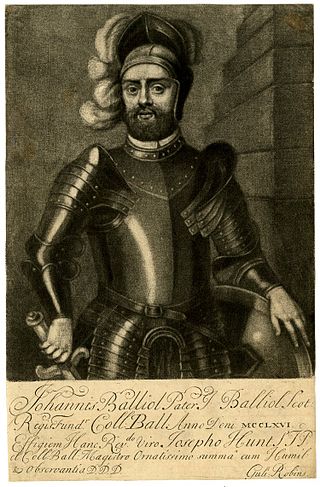Related Research Articles

Henry IV, also known as Henry Bolingbroke, was King of England from 1399 to 1413. Henry was the son of John of Gaunt, Duke of Lancaster, and Blanche of Lancaster.

James I was King of Scots from 1406 until his assassination in 1437. The youngest of three sons, he was born in Dunfermline Abbey to King Robert III and Annabella Drummond. His eldest brother David, Duke of Rothesay, died under suspicious circumstances while detained by his uncle, Robert, Duke of Albany. James's other brother, Robert, died young. Concerns for James's safety deepened in the winter of 1405–1406 prompting plans to send him to France. In February 1406, James took refuge in the castle of the Bass Rock in the Firth of Forth after his escort was attacked by supporters of Archibald, 4th Earl of Douglas. He remained there until mid-March when he boarded a vessel bound for France. On 22 March, an English vessel captured the ship and delivered James to Henry IV of England. The ailing Robert III died on 4 April and the 11-year-old James, now the uncrowned King of Scotland, would remain in captivity for eighteen years.

Robert II was King of Scots from 1371 to his death in 1390. The son of Walter Stewart, 6th High Steward of Scotland, and Marjorie, daughter of King Robert the Bruce, he was the first monarch of the House of Stewart. Upon the death of his uncle David II, Robert succeeded to the throne.

Robert III, born John Stewart, was King of Scots from 1390 to his death in 1406. He was also High Steward of Scotland from 1371 to 1390 and held the titles of Earl of Atholl (1367–1390) and Earl of Carrick (1368–1390) before ascending the throne at about the age of 53 years. He was the eldest son of King Robert II and Elizabeth Mure and was legitimized by the second marriage of his parents and by papal dispensation in 1349.

Robert Stewart, Duke of Albany was a member of the Scottish royal family who served as regent to three Scottish monarchs. A ruthless politician, Albany was widely regarded as having murdered his nephew, the Duke of Rothesay, and brother to the future King James I of Scotland. James was held in captivity in England for eighteen years, during which time Albany served as regent in Scotland, king in all but name. He died in 1420 and was succeeded by his son, Murdoch Stewart, Duke of Albany, who was executed for treason when James returned to Scotland in 1425, almost causing the complete ruin of the Albany Stewarts.

John de Balliol was an English nobleman, belonging to the House of Balliol. Balliol College, in Oxford, is named after him.
Uhtred mac Fergus was Lord of Galloway from 1161 to 1174, ruling jointly with his brother Gille Brigte (Gilbert). They were sons of Fergus of Galloway; it was believed that they were half brothers, but Duncan of Carrick was addressed as cousin by the English King, as was Uchtred.. Their mother's name is not known for sure, but she must have been one of the many illegitimate daughters of Henry I of England, most likely Elizabeth Fitzroy.
Lochlann of Galloway, also known as Lochlan mac Uchtred and by his French name Roland fitz Uhtred, was the son and successor of Uchtred, Lord of Galloway as the "Lord" or "sub-king" of eastern Galloway.

Donnchadh IV, Earl of Fife [Duncan IV] (1289–1353) was a Scottish nobleman who was Guardian of Scotland and the last native Scottish Mormaer of Fife from 1289 until his death.
Gille Críst, Earl of Angus ruled until 1206 Mormaer of Angus. He was a son of Gille Brigte of Angus and younger brother of Adam of Angus.

de Lacy is the surname of an old Norman family which originated from Lassy, Calvados. The family took part in the Norman Conquest of England and the later Norman invasion of Ireland. The name is first recorded for Hugh de Lacy (1020–1085). His sons, Walter and Ilbert, left Normandy and travelled to England with William the Conqueror. The awards of land by the Conqueror to the de Lacy sons led to two distinct branches of the family: the northern branch, centred on Blackburnshire and west Yorkshire was held by Ilbert's descendants; the southern branch of Marcher Lords, centred on Herefordshire and Shropshire, was held by Walter's descendants.
Ermengarde de Beaumont was Queen of Alba as the consort of William the Lion. She is reported to have exerted influence over the affairs of state as queen, though the information on her is lacking in detail. Her paternal grandmother was Constance FitzRoy, illegitimate daughter of Henry I of England.
John Comyn (Cumyn) was Lord of Badenoch in Scotland. He was Justiciar of Galloway in 1258. He held lands in Nithsdale and Tynedale.
Walter FitzAlan was a twelfth-century Anglo-Norman baron who became a Scottish magnate and Steward of Scotland. He was a younger son of Alan fitz Flaad and Avelina de Hesdin. In about 1136, Walter entered into the service of David I, King of Scotland. He became the king's dapifer or steward in about 1150, and served as such for three successive Scottish kings: David, Malcolm IV and William I. In time, the stewardship became hereditarily held by Walter's descendants.

Alan fitz Walter was hereditary High Steward of Scotland and a crusader.
Clement was a 13th-century Dominican friar who was the first member of the Dominican Order in Britain and Ireland to become a bishop. In 1233, he was selected to lead the ailing diocese of Dunblane in Scotland, and faced a struggle to bring the bishopric of Dunblane to financial viability. This involved many negotiations with the powerful religious institutions and secular authorities which had acquired control of the revenue that would normally have been the entitlement of Clement's bishopric. The negotiations proved difficult, forcing Clement to visit the papal court in Rome. While not achieving all of his aims, Clement succeeded in saving the bishopric from relocation to Inchaffray Abbey. He also regained enough revenue to begin work on the new Dunblane Cathedral.
Walter de Coventre was a 14th-century Scottish ecclesiastic. There is no direct evidence of his birthdate, his family, or his family's origin, although he may have come from the region around Abernethy, where a family with the name de Coventre is known to have lived. Walter appeared in the records for the first time in the 1330s, as a student at the University of Paris. From there he went on to the University of Orléans, initially as a student before becoming a lecturer there. He studied the arts, civil law and canon law, and was awarded many university degrees, including two doctorates. His studies were paid for, at least partially, by his benefices in Scotland. Despite holding perhaps more than five benefices at one stage, he did not return to Scotland until the late 1350s.

Richard Óg de Burgh, 2nd Earl of Ulster and 3rd Baron of Connaught, called The Red Earl, was one of the most powerful Irish nobles of the late 13th and early 14th centuries and father of Elizabeth, wife of King Robert the Bruce of Scotland.
William Comyn, Lord of Kilbride was a son of David Comyn and Isobel de Valognes. Sheriff of Ayr in 1263, he died in 1283.
Sir Walter de Olifard, Lord of Bothwell and Abernethy and Justiciar of Lothian, was a Scottish noble.
References
- Taylor, Alice (2016). The Shape of the State in Medieval Scotland, 1124-1290. Oxford Studies in Medieval European History. Oxford University Press. ISBN 9780191066108.